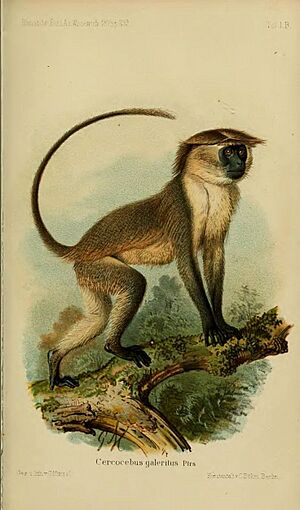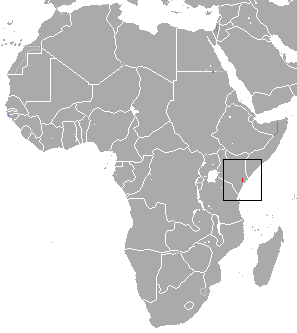Tana River mangabey facts for kids
Quick facts for kids Tana River mangabey |
|
|---|---|
 |
|
| Conservation status | |
| Scientific classification | |
| Genus: |
Cercocebus
|
| Species: |
galeritus
|
 |
|
| Tana River mangabey range | |
The Tana River mangabey (Cercocebus galeritus) is a type of primate (a group of mammals that includes monkeys, apes, and humans). It's a very rare and endangered animal. This special monkey lives only in a small area of Kenya, along the Tana River.
Sadly, the Tana River mangabey is losing its home. Its forest home is shrinking because of human activities. To help protect these monkeys and another endangered species called the Tana River red colobus, the Tana River Primate Reserve was created in 1978. Even with the reserve, people are still moving into the area. There was a plan to turn a large part of the Tana River Delta into sugarcane farms, but a court in Kenya has stopped this for now.
Contents
What Does the Tana River Mangabey Look Like?
The Tana River mangabey is a medium-sized monkey. It has a long tail that can help it grip things. Its fur is yellow-brown, and it has a dark stripe of long fur down the middle of its head. Like other Cercocebus monkeys, it has white eyelids that stand out against its darker face. Scientists think these white eyelids help the monkeys communicate with each other. This monkey also has special teeth that are good for cracking open hard nuts, seeds, and fruits.
How Do Tana River Mangabeys Live?
Tana River mangabeys are active during the day. They spend most of their time on the ground, but they are also good at climbing trees. They sleep high up in trees, usually between 27 and 37 meters (about 90 to 120 feet) off the ground. They pick trees with open tops, sleeping in the forks of branches or near the main trunk. Sleeping in trees helps keep them safe from predators.
Mangabeys live in groups that can have 13 to 36 monkeys. Sometimes, several groups might gather together, forming a larger group of 50 to 60 individuals. These groups have both male and female monkeys. They usually travel about 1.25 kilometers (less than a mile) each day.
During the dry season, when food is harder to find, different groups stay in their own areas. Males will make loud calls and show off to protect their space. They might even fight with other male leaders who try to enter their territory. But in the wet season, when there's plenty of food, the boundaries between groups break down. Groups are more friendly and might even mix with each other.
Some animals that hunt the Tana River mangabey include the Central African rock python, crowned eagle, martial eagle, and Nile crocodile.
Reproduction and Family Life
Tana River mangabeys are polygynous, meaning one male might mate with several females. Each group usually has two or more adult males, depending on its size. Male mangabeys are much bigger than females. An adult male weighs about 10.2 kilograms (22.5 pounds), while an adult female weighs about 5.5 kilograms (12 pounds).
A female mangabey gives birth to one baby after being pregnant for about 170 to 180 days. For the first two months, the mother keeps her baby very close, and they form a strong bond. By the third month, the baby starts playing with other young monkeys and adults in the group. However, it still stays close to its mother. Female mangabeys often stay close to their mothers for life. Male mangabeys become more independent and spend more time away from the main group. If a group loses a male, another male from outside the group might join to help keep the group stable.
What Do Tana River Mangabeys Eat?
The Tana River mangabey is an omnivore, which means it eats both plants and animals. Its diet includes leaves, seeds, fruits, insects, and even bird or reptile eggs. They are opportunistic feeders, meaning they eat whatever they can find. They often search for food in the fallen leaves on the forest floor.
Even though they spend a lot of time on the ground, they get most of their food from trees. They eat fruits and seeds from about 50 different types of trees. Mangabeys spend nearly half their day (48%) looking for food. They spend 15% of the day sleeping and 14% resting. About 46.5% of their yearly diet is seeds, and 25.6% is fruit. Two very important food sources are the Ficus sycomorus tree, which produces fruit all year, and Phoenix reclinata, which provides food when other trees don't.
Their teeth are perfectly designed for their diet. They have large incisors (front teeth) to tear the tough skin of fruits. Their large back teeth (premolars) have a big surface area to crush seeds. Their short faces also give them a strong bite.
Where Do Tana River Mangabeys Live?
The Tana River mangabey lives in the southeastern part of Kenya, along the Tana River. They are found in about 27 small patches of forest along a 60-kilometer (37-mile) stretch of the river. These forests are called gallery forests because they form a "gallery" or tunnel along the riverbanks.
Many other primates live in these gallery forests, including the Tana River red colobus, blue monkey, yellow baboon, vervet monkey, and two types of bush babies. The Tana River mangabey can only live in these specific riverine forests. These forests are naturally broken up by the river's winding path and changing water levels. However, human activities are making the forests even more broken up, which makes it harder for the mangabeys to survive.
Protecting the Tana River Mangabey
One of the biggest dangers to endangered species like the Tana River mangabey is losing their habitat. In the last 20 years, about half of the original forest where they live has been destroyed. People are cutting down trees in the Tana River area to make space for farms. They also cut down large trees to build canoes, collect wild honey, and use palm leaves for roofs and mats. Smaller trees are used for building houses, and the tops of Phoenix reclinata palms are cut for palm wine. All these activities reduce the resources the mangabeys need to survive. Sometimes, Tana River mangabeys are also hunted or trapped if they damage local crops, though this seems to happen only a little.
The Tana River mangabey is listed as one of The World's 25 Most Endangered Primates. In 1994, experts estimated there were only about 1,000 to 1,200 of these monkeys left. The United States listed them as endangered in 1970. The International Union for Conservation of Nature (IUCN) lists them as critically endangered, which is the highest risk category. They are also protected under CITES (a global agreement to control trade in endangered animals) and the African Convention on the Conservation of Nature and Natural Resources.
The Tana River Primate Reserve was set up in 1976 to protect the remaining forest and the Tana River mangabey. The reserve covers about 171 square kilometers (66 square miles), with two main forested areas. About 56% of the Tana River mangabey groups live inside this reserve, while 44% live in forests outside it. Some groups outside the reserve are managed by a project called the Tana Delta Irrigation Project.
The main goal of the Tana River Primate Reserve was to protect the amazing variety of life (the biodiversity) in the Tana River area, especially the endangered Tana River mangabey. Protecting this monkey is very important for animal conservation in Kenya. However, in 2007, a court in Kenya ruled that the reserve was not following its own rules. This meant the forests where the mangabeys lived lost their legal protection.
The Tana Delta Irrigation Project has not been managed well, and habitat loss continues outside the reserve. The group in charge of this project is planning to expand a sugarcane plantation, which will destroy even more forest.
In 1996, a five-year project was started with the Kenya Wildlife Service and Kenya Forest Department, funded by the World Bank and Global Environment Facility. The project aimed to improve the protection of these monkeys and their forests. But the project was not managed well and ended after only two years, leaving the wildlife service to protect the areas alone.
There is a community effort called the Ishaqbin Conservancy within the Tana River Primate Reserve. Local communities are working with the Kenya Wildlife Service to develop tourism alongside conservation. They believe that tourism will help protect the habitat and the mangabeys. It will also help the local communities by creating jobs and reducing the need to cut down forests. This conservancy will also create a safe zone around the reserve, helping to reduce human impact inside it.
Images for kids




